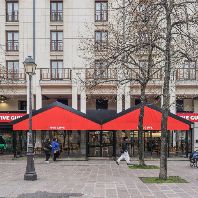Germany's luxury shopping streets were in good shape in 2009, when tenancy turnover was lower than in the previous years. Thanks to good demand, the few properties that became vacant were re-let without any problem and at stable rents. "International luxury brands continue to invest in their branch networks and regard the European luxury destinations as "must locations," says Doris von Muschwitz, Head of Retail Letting at Jones Lang LaSalle Germany.
"Led by Düsseldorf's Königsallee and Munich's Maximilianstraße, Germany has a total of five luxury destinations, a number that is certainly internationally competitive. The German streets need not fear comparison with New Bond Street or Rue Faubourg St. Honoré in Paris right on the contrary, they have an equally high density of luxury labels, while prime rents are relatively low. Germany's streets, above all Düsseldorf's Königsallee, were also among the leaders in Western Europe in terms of the number of new arrivals in 2009."
Density of luxury labels: Düsseldorf's Königsallee and Munich's Maximilianstraße almost on a par with London's New Bond Street London's New Bond Street has the highest density of international luxury labels; 30 of the 50 top luxury brands defined by Jones Lang LaSalle are based here. New Bond Street is followed by Rue du Faubourg St. Honoré in Paris, Königsallee in Düsseldorf and Maximilianstraße in Munich with 27 high-end labels each. 25 brand shops are situated on Berlin's Kurfürstendamm and London's second top location, Sloane Street. Hamburg's Neuer Wall and Zurich's Bahnhofstraße have 22 and 21 top brands, respectively, while 20 labels can be found in Frankfurt's Goethestraße, Milan's Via Montenapoleone and Avenue Montaigne in Paris. They are followed by Via Condotti in Rome and Calle Ortega Y Gasset in Madrid, with 19 and 16 labels, respectively.
In Germany, the luxury brands are concentrated in one street per city, whereas cities such as London and Paris, in particular, have several high-quality luxury shopping destinations. In this respect, Paris is the uncontested No. 1 luxury city in Western Europe. In addition to the two streets mentioned above, the French capital has at least two other renowned locations, namely Place Vendome, which primarily attracts luxury jewellers, and Boulevard Haussmann. Between them, London's New Bond Street and Sloane Street are home to over 50 luxury brands.
Presence of luxury brands: Top labels have up to 13 shops in the 15 luxury shopping streets surveyed With 13 boutiques each, Gucci and Salvatore Ferragamo have the strongest presence in the 15 Western European top locations surveyed. They are followed by Bulgari, Cartier, Louis Vuitton and Prada, with 12 stores each. Giorgio Armani, Hermès and Tod's stores can be found in 11 of the 15 streets. Chanel, Tiffany & Co and luxury phone provider Vertu have 10 stores each. Between them, the 50 leading luxury brands operate some 320 stores in the streets surveyed.
Rents: Luxury locations in London and Paris achieve the highest rents German locations relatively inexpensive The most expensive luxury shopping street in Western Europe is Via Montenapoleone in Milan, where annual rents of up to 6,800 per square metre of retail space are paid. It is followed by Via Condotti in Rome with up to 6,500/m² and London's New Bond Street with 6,440/m². With regard to the Italian luxury locations, it should be noted that the prime rents apply only to absolute top locations in what is a relatively intransparent letting market. Annual rents in excess of 5,000/m² are generated in Avenue Montaigne in Paris and Zurich's Bahnhofstraße. Prime rents in Germany's luxury shopping streets are below the Western European average in all cities. With the exception of Munich's Maximilianstraße, where annual prime rents exceed 3,700/m², annual rents in all German locations range from 2,300 to 2,800/m². Similarly low rents are paid only in Spain's luxury locations. Jones Lang LaSalle expects rents in Germany to remain stable at the present level in 2010.
Source: JLL













